10 False Facts About French Fries You Probably Thought Were True
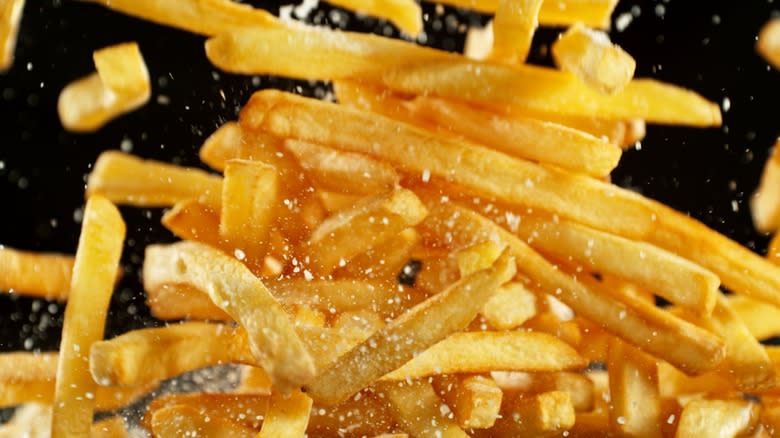
French fries are such a popular dish all around the world and have been for centuries. Although you might think McDonald's invented the food in recent years and you can only eat it as a side, this isn't true. You might even be shocked to learn that french fries might not even be from France, although this one is a little bit controversial.
Like with any popular food, there are plenty of misconceptions about french fries, but we're here to set the record straight. That is, yes, you absolutely can enjoy them as a complete meal, despite what your mom might have told you. You can even make purple fries. This is shocking, we know. Plus, believe it or not, there are ways to prepare this fast food favorite in a healthy way, if you are worried about that sort of thing.
By buying into any of these false facts surrounding french fries, you're denying yourself the sheer joy of indulging in their deliciousness to the fullest. So, it's time to put those misconceptions aside and embrace all the wonderful possibilities that french fries offer. Here's the truth.
Read more: The Ultimate American Fast Food Restaurants Ranked
False Fact: French Fries Are Always Made With White Potatoes
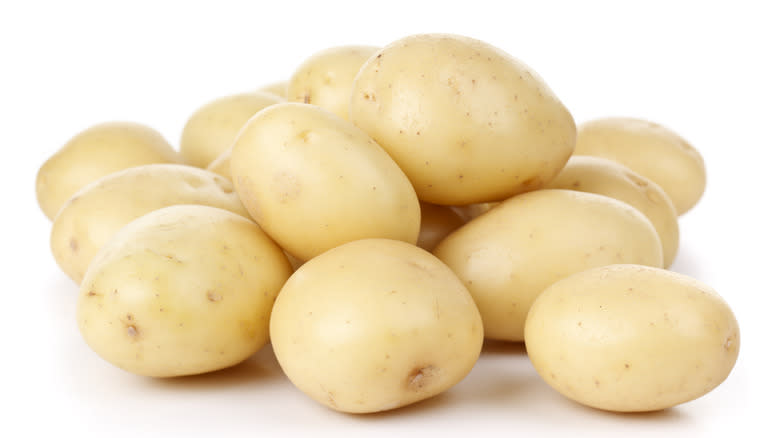
While most french fries come from Russet potatoes, it's fun (and possible) to branch out to other types of spud. There are so many different potato varieties to choose from that you shouldn't limit yourself when in the kitchen. Sometimes called Idaho potatoes, Russet potatoes get their name from their distinctive skin color. They are very starchy, making them great for fries; however, so many other options taste just as delicious. Kipfler potatoes, for example, work best when roasted — meaning your fries will be thick and hearty, kind of like a steak fry.
Russian banana potatoes also make great fries because they are so long and curved; you have less preparation to do as it only takes a few chops until they are fry-shaped and ready to go. If you want some color on your plate, you can even reach for purple majesties with an almost lavender interior that fries up quite nicely. And of course, you can't forget about sweet potato fries. This orange, honeyed option is a classic twist and easy to find on menus. All this to say is that if it's a potato, it can be a french fry.
False Fact: French Fries Come From France

You might assume that french fries must come from France. After all, it's right there in the name. However, they are likely Belgian in origin — yet this is a controversial and much-debated truth. There are two main theories about the origin of the dish's name. The first is that those who lived along the River Meuse in Belgium relied on fried fish for the majority of their diet. However, when the river was frozen over in the winter, they fried up potatoes instead of ice fishing. When American soldiers came to the area during the World War I, they came home calling the dish "french fries" because the people in the area spoke French.
The second theory, and those that any modern Frenchmen will have you believe, is that french fries were invented by Parisians in the 1780s and sold on the streets out of carts. Thus, when encountered by Americans, the food became known as "french fries" because the potatoes were fresh off the avenues of Paris. The truth is still broiled in mystery, but according to many, the French attribution will always be a bit of a misnomer.
False Fact: Salt Is The Only Seasoning Used On French Fries
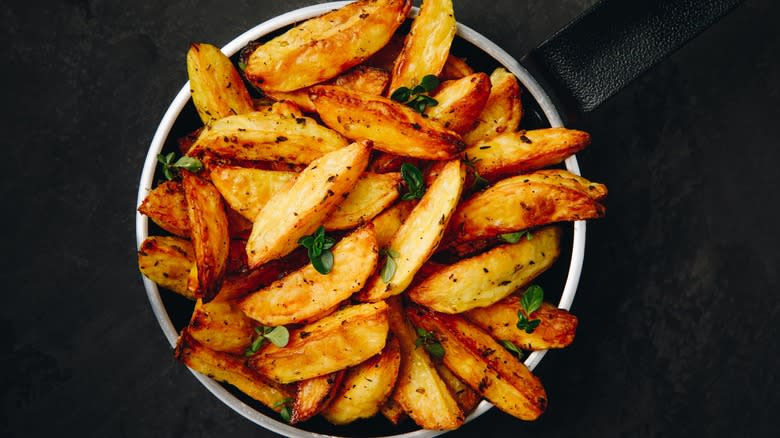
While salted fries are certainly the most classic option, this doesn't mean you should limit yourself when seasoning your favorite snack. Don't be afraid to be bold and branch out — you never know what seasoning will take them to the next level. Australians, for example, swear up and down that chicken salt is the way to go. The savory seasoning became popular in the 1970s and is now the go-to option for most Aussies when they order chips, as they call french fries. While recipes vary, it tends to include chicken skin, mushroom powder, salt, pepper, garlic, and onion powder blended into a savory, sharp seasoning that elevates fries with a nice kick to each bite.
If that's not your thing, or you prefer to keep your seasoning vegetarian, consider adding paprika to your plate. Fries smothered in smoked paprika give a real BBQ kick to the dish. Other options include garlic powder, truffle oil, or even a blend of Italian herbs. Think of the potato as a blank canvas. Most flavors and textures blend with potatoes, so the sky truly is the limit with seasoning options.
False Fact: French Fries Are A Modern Fast Food Invention

Most modern diners typically associate French fries with fast food. They are nearly synonymous with McDonald's as a "burger and fries" is the classic drive-thru meal. However, this couldn't be farther from the truth as the food is actually centuries old. French fries have been around since the 1600s, and possibly even earlier according to some scholars. In fact, the very first documentation of a sort of french fry was as early as 1553. Pedro Cieza de Leon, a Spanish conquistador, kept records of his time in South America. His book is rather lengthily titled, "The Chronicle of the Incas, or the Seventeen-Year Travel of Pedro Cieza de Leon Throughout the Mighty Kingdom of Peru." He wrote that those living in Peru at the time ate "a kind of earth nut which, after it is boiled, is as tender as cooked chestnuts." Upon returning to Spain, the potatoes were likely fried up to be eaten, as Spaniards enjoyed cooking food in oil during that time.
Although these would not have looked or tasted like the modern french fry, they were certainly a start. From there, it is thought that the Spaniards brought the idea to the northern part of the country, where French-speaking communities shaped the food into the dish we love today. But this was all happening in the 1600s, well before the Golden Arches.
False Fact: Different Cuts Of Fries Taste Different
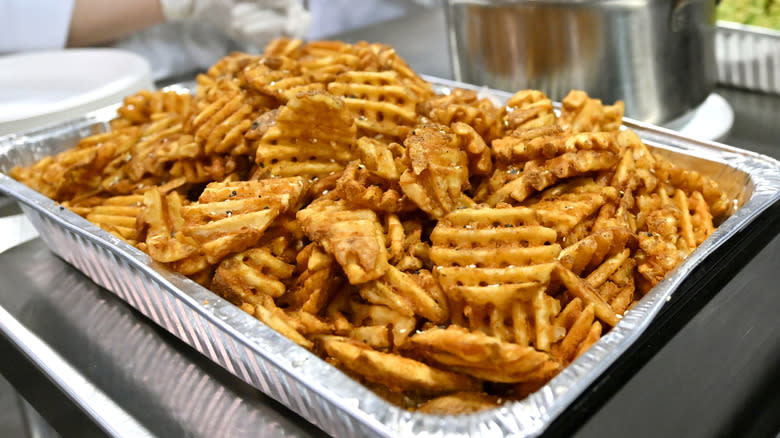
We all have our favorite type of fry. Maybe you are convinced that the waffle fries from Chick-fil-A are God's gift to fast food diners, or the curly fries from Arby's taste superior to all other others you have ever tried. Steak fries might be gross to you, but you love the shoestring option available at In-N-Out. You aren't alone in thinking that different cuts of fries taste well, different, which is why it is such a common false fact. Even the most accomplished of food critics have their fry-cut preferences.
However, while it's fun to rank textures and cuts, from waffle to crinkle to curly, the cut of a fry doesn't necessarily impact its taste. What does change the taste of the food is the quality of the potato used to create it, its seasoning, the oils used, cooking method, and how well it was cooked. For example, a waffle fry cooked in recently changed peanut oil and seasoned with salt is going to taste a lot different than a curly fry that's just come out of a fryer with grease that hasn't been changed in days. While we might prefer straight-cut fries over wedges, the difference in taste doesn't come from their shape itself.
False Fact: French Fries Are Only Served As A Side Dish
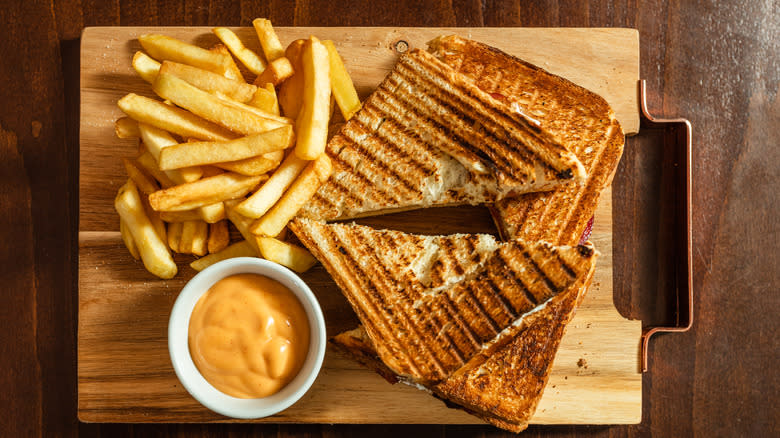
It is true that "and a side of fries, please" is likely one of the most common things we say when out to eat. Whether it's a drive-thru or a steak house, potatoes tend to make a great sidekick for any meal. However, it's a myth to think that the dish can't be made into the main course, too. There are so many quick and easy ways to turn this snack into a meal.
For example, if you're craving a touch of Mexican food, consider making loaded taco fries. Think of these a bit like nachos that have fries as the base instead of chips. If that's not your thing, you can also elevate your fries by adding gravy and cheese to them, mimicking Canada's famous poutine. Loaded chili cheese fries also hit all the mainstays of a fulfilling meal, with plenty of carbs, protein, and fat to keep you satisfied for hours. By taking fries out of the side dish-only category, you open up so many delicious options for yourself.
False Fact: French Fries Are Always Fried In Oil
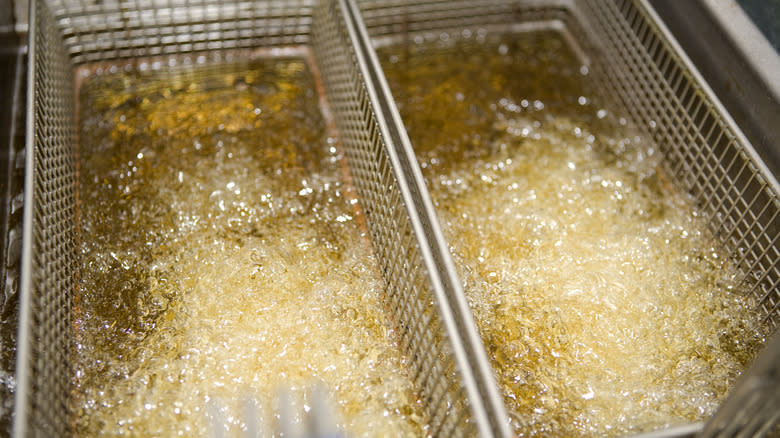
French fries have long been associated with deep frying, leading to the misconception that they can only be cooked in oil. However, the truth is that they can be prepared using alternative methods such as baking in an oven or using an air fryer. Not only do these options reduce the amount of oil used, but they also yield fries that are just as crispy and delicious as their deep-fried counterparts.
Air fryers work their magic by circulating hot air around the potatoes, creating a golden, crispy exterior while locking in moisture to ensure a fluffy interior. The rapid air circulation mimics the effect of deep frying, allowing the fries to crisp up evenly without the need for submerging them in oil. Baking french fries in the oven is another excellent option for achieving that perfect balance of crispy and tender. By arranging the potato strips in a single layer on a baking sheet and using a light amount of oil or cooking spray, the fries can crisp up beautifully in the oven. The key to success lies in preheating the oven to a high temperature, typically around 425 degrees F. Flipping the fries halfway through the cooking process also promotes even browning and crispiness on all sides.
False Fact: French Fries Are Difficult To Make At Home
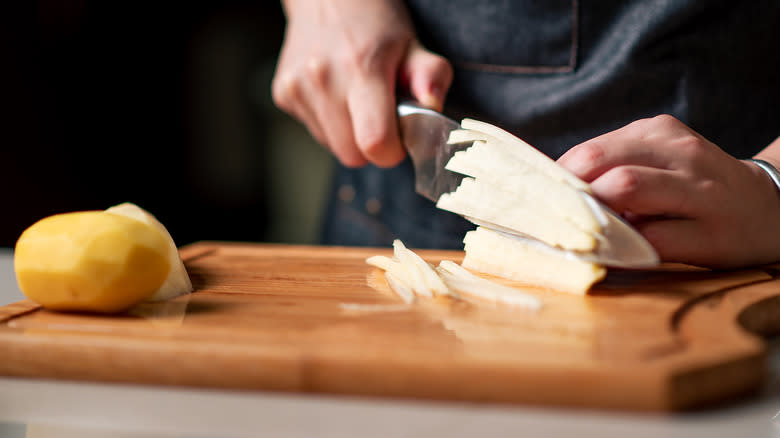
If you love french fries, you will be relieved to know that making them at home is pretty easy. It's a myth that it's hard to do. You can enjoy restaurant-quality fries at home in less than an hour in most cases. First, you must always wash your potatoes. Nothing can ruin the flavor of the dish by tasting any leftover dirt on the skin. Next, peel the potatoes — or not, your choice. Some even think that leaving the skin on makes the fries taste even better. However, peeling can be tedious to others, so if this is you, feel free to skip this step. Then, cut the potatoes into the shape you desire.
The key to making restaurant-quality fries at home is this next step: Soak the potato slices in ice-cold water for about 30 minutes. This will pull the excess starch making them nice and crispy when cooked. After patting the potatoes dry, it's time to cook them. While traditional deep frying produces classic french fries, this can be difficult to master for beginners. For a quick and easy alternative, try oven baking, air frying, or even pan-frying with minimal oil. Remember, whatever you choose, don't overcrowd the cooking vessel as that can lead to uneven cooking and soggy fries.
False Fact: French Fries Are Always Served With Ketchup
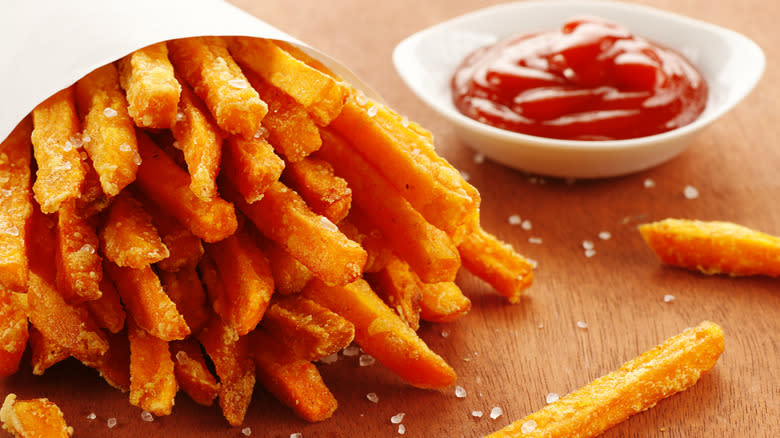
While ketchup is a popular dip for fries, it's a myth to think that the tomato paste is the only sauce that works well. While its tangy sweetness certainly makes ketchup a front-runner, you're missing out if you don't try other popular options from around the globe. For example, many Europeans prefer enjoying their fries with mayo or aioli. Its subtle tanginess complements the potatoes' natural sweetness.
Germans like to use mustard as a sauce for their fries, as its bold, zesty flavor adds a punch to each bite. Whether it's classic yellow or whole-grain Dijon, the sharpness of mustard cuts through the richness of fried potatoes forming a winning combo. Australians, Kiwis, and even the Brits also reach for vinegar as a sauce for their fries. In these regions, fries are typically served with malt vinegar, adding a tangy kick to enhance the flavor without overpowering them. Vinegar chips are best enjoyed when heavily salted. If you aren't sure about any of these options, next time you order fries, just get them alongside your ketchup packet. This way, if you aren't impressed, you can always switch back.
False Fact: French Fries Are Always Unhealthy
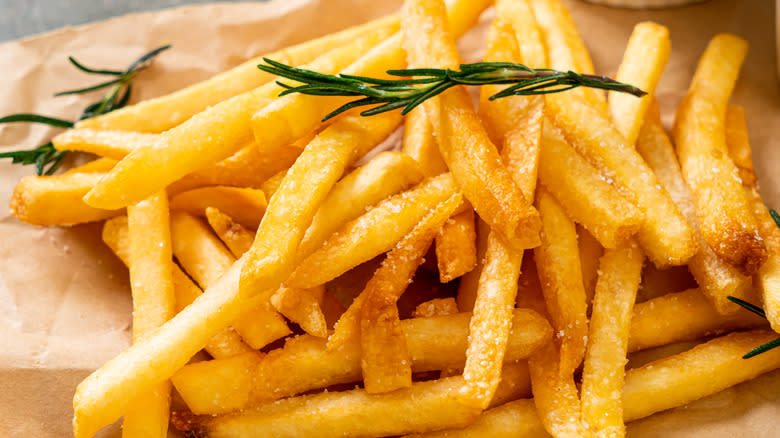
Sure, fast food french fries deep fried in grease and covered in salt and sugar might not be the healthiest food option. However, if you still want to enjoy the dish, there are ways of making things healthier if you cook them yourself. For example, consider baking your fries or using an air fryer rather than cooking them in oil. This can reduce the overall calorie and fat content of the fries, making them a lighter option.
If you feel like you just can't replicate the crunch you crave with baking or an air fryer, swapping out the type of oil can also have a positive impact on the potatoes. Instead of vegetable oil, try some of the other best cooking oils for fries, such as olive oil, avocado oil, or rice bran oil. These oils contain healthier fats than more traditional options.
In addition to cooking methods, consider the seasoning you use on your fries. Those who need to lower their sodium intake could omit the salt, and instead consider options like Italian herbs or paprika.
False Fact: French Fries Are Always Made From Potatoes
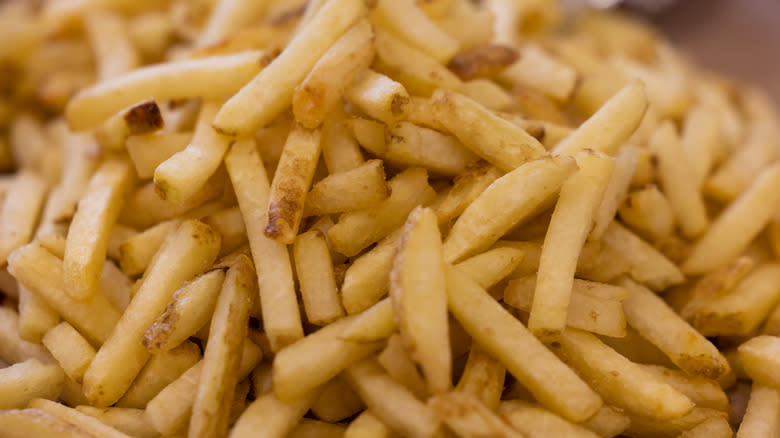
While French fries are traditionally made with potatoes, there are plenty of options to put a fun twist on the classic dish with other vegetables, too. These variations are great for those who might need to cut back on carbs in their diet, or others who simply don't like the taste of potato.
One of the first delicious twists is making crispy carrot fries. If you use enough oil on carrots and bake them properly, they can soften up and mimic the texture of a spud quite nicely. Another option is zucchini fries that you don't even have to fry. Simply sprinkle slices of the vegetable with panko bread crumbs to give them a nice crunch and throw them in the oven to bake. They taste great if served with salsa or ketchup and make a great "green" alternative. The possibilities are endless, with eggplant also being a great potato replacement. Especially when served with tahini as a dipping sauce, you will hardly be able to tell that you aren't eating potatoes.
Read the original article on Daily Meal.